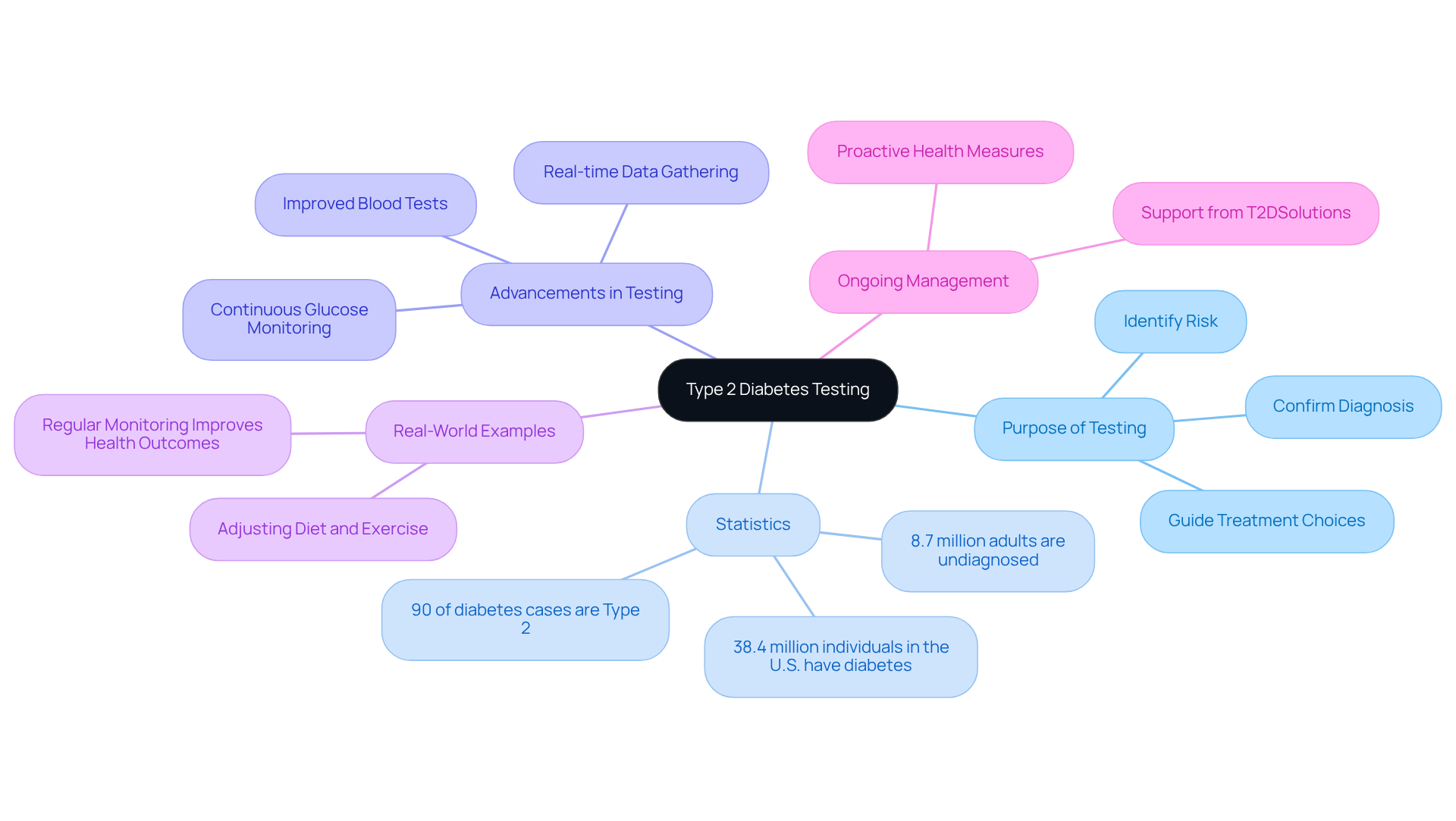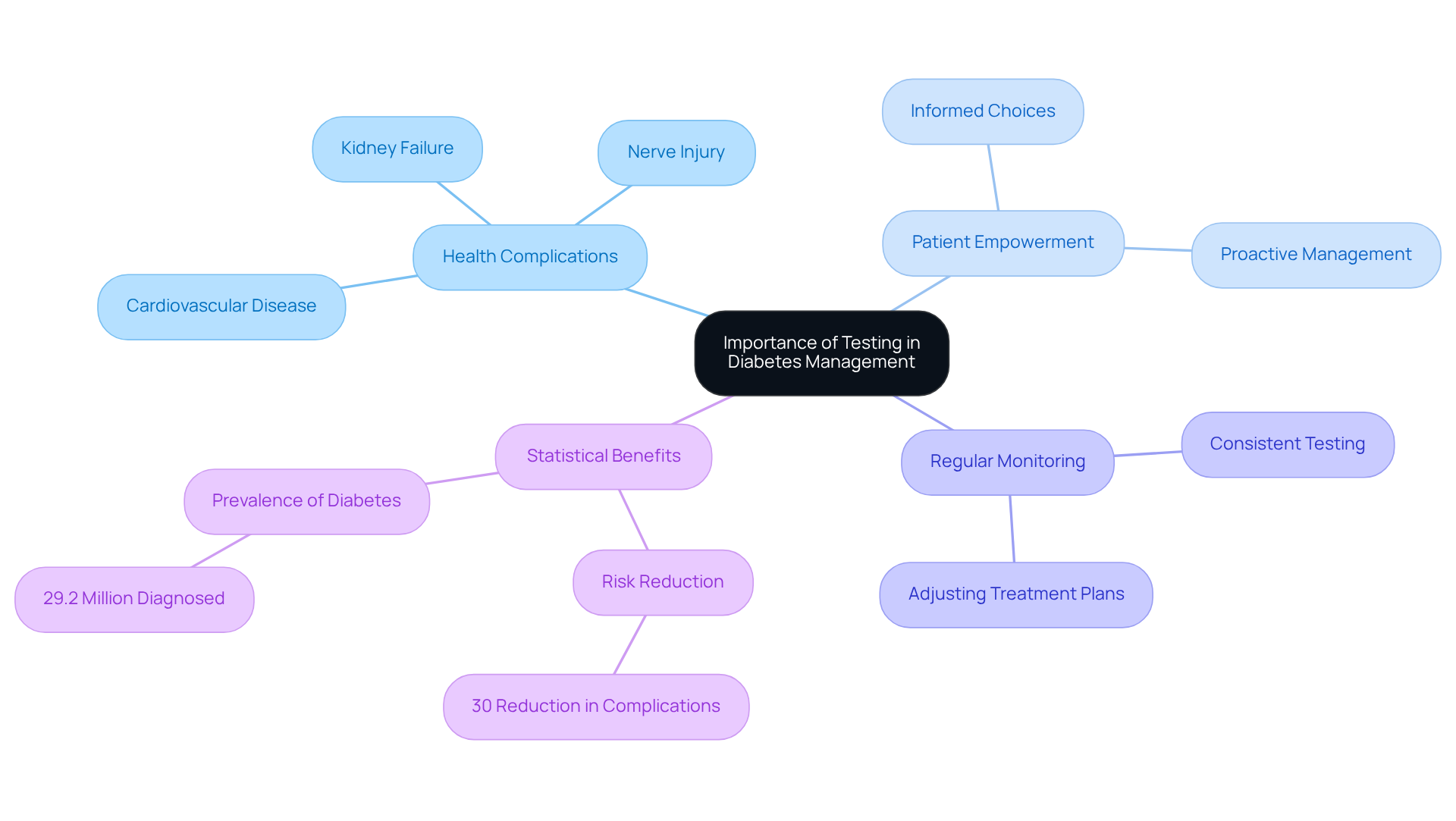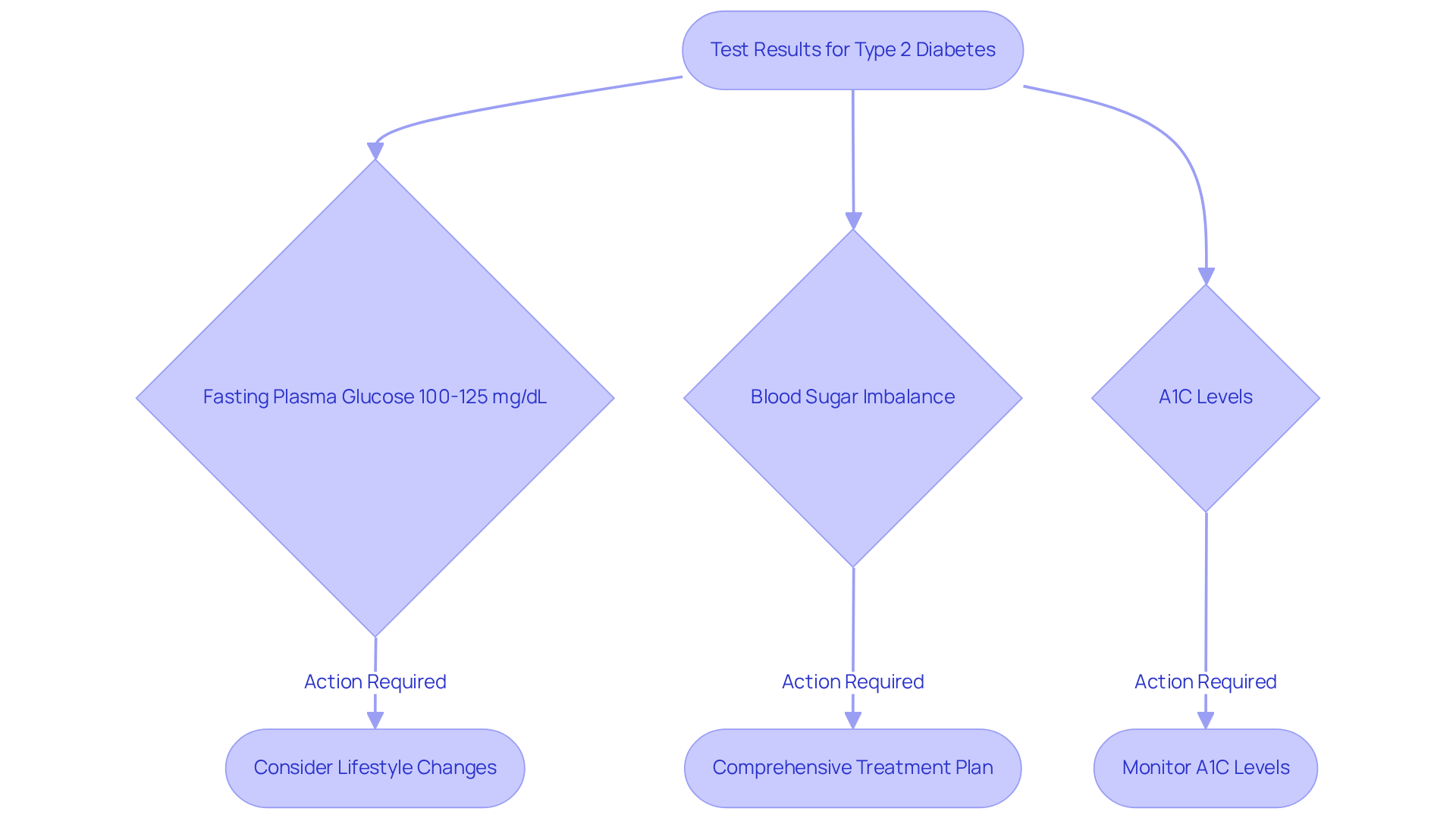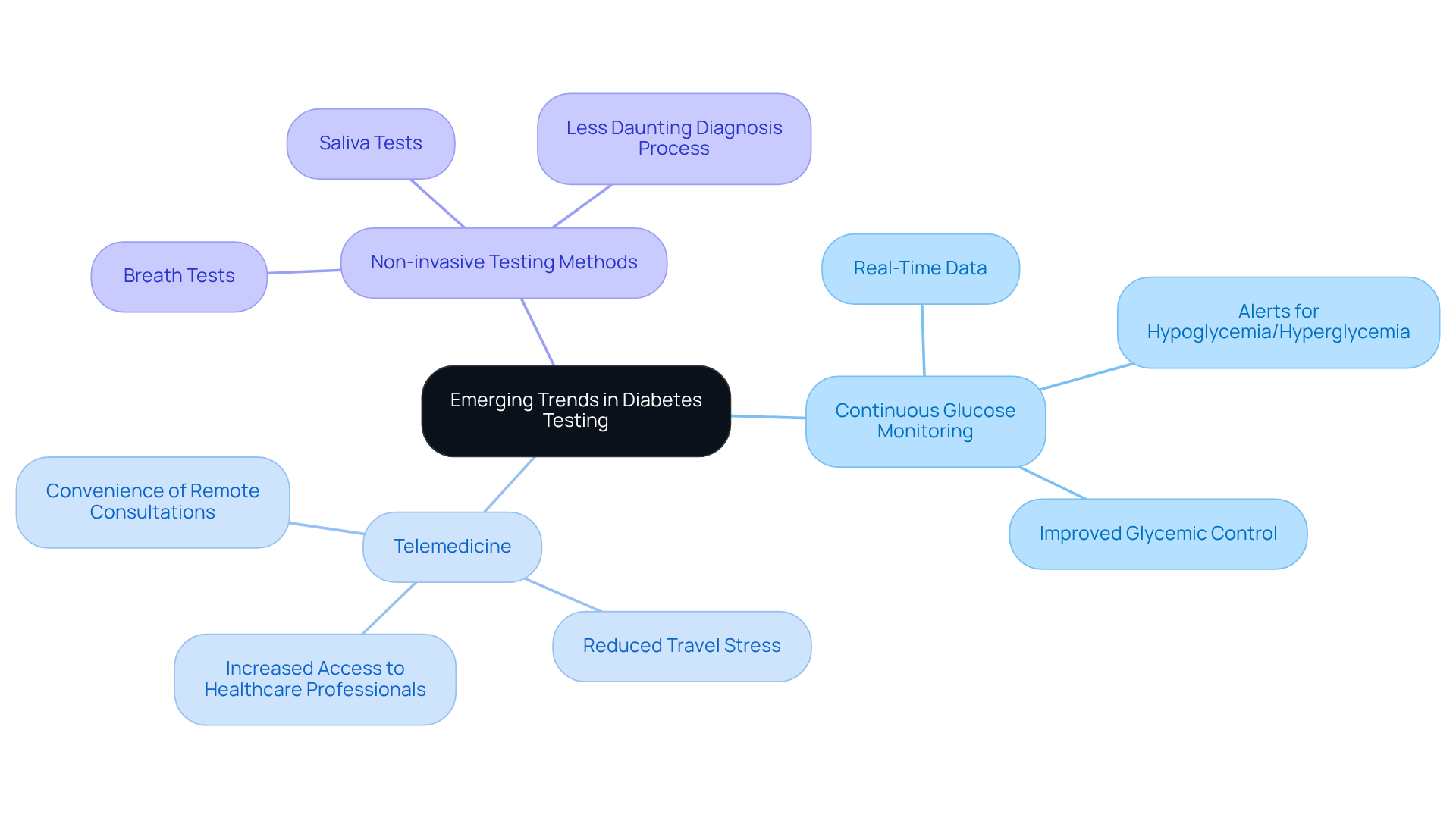Overview
This article highlights the vital role of testing in diagnosing and managing type 2 diabetes. It's understandable to feel overwhelmed by this condition, but regular testing is crucial for early diagnosis and effective management. These tests help monitor blood glucose levels, guiding necessary lifestyle changes and treatment plans. By staying proactive, you can significantly reduce the risk of severe complications associated with diabetes. Remember, you're not alone in this journey; we are here to support you every step of the way.
Introduction
Understanding the landscape of type 2 diabetes testing is crucial, especially when nearly 40% of individuals with diabetes face severe complications due to undiagnosed conditions. It’s important to recognize that these tests not only serve as a diagnostic tool but are also vital for ongoing management and prevention strategies. With advancements in technology and testing methods, individuals can now monitor their blood sugar levels with greater accuracy and convenience.
However, it's understandable to feel overwhelmed by the complexities of these tests. How can you navigate this landscape to ensure optimal health outcomes and avoid the pitfalls of this prevalent condition? You're not alone in this journey. We are here to support you every step of the way.
Define Type 2 Diabetes Testing
Tests for type 2 diabetes involve various medical assessments aimed at diagnosing and monitoring the condition by measuring blood glucose levels and assessing the body's capacity to process sugar. It's understandable to feel overwhelmed by this information, but know that the main goal of these tests is to identify individuals at risk of developing the condition or to confirm a diagnosis in those showing symptoms. Tests for type 2 diabetes play a crucial role in effectively managing the condition, guiding treatment choices and lifestyle changes necessary for maintaining optimal health.
Recent statistics indicate that approximately 38.4 million individuals in the U.S. have this condition, with Type 2 accounting for about 90% of these instances. The prevalence of undiagnosed blood sugar disorders remains a significant concern, with an estimated 8.7 million adults unaware of their condition. Early identification through consistent testing is essential, as it can lead to prompt actions that help avoid complications related to this health condition.
Advancements in glucose testing methods, such as continuous glucose monitoring and improved blood tests, have enhanced the accuracy and convenience of tracking blood sugar levels. These innovations allow for real-time data gathering, empowering you to make informed choices regarding your health.
Real-world examples illustrate the effectiveness of regular testing in managing blood sugar levels. For instance, individuals who regularly monitor their blood glucose are often better prepared to adjust their diets and exercise habits, resulting in improved health outcomes.
At T2DSolutions, we strive to assist you in recognizing the significance of Type 2 testing and offer resources for continuous management and education. By incorporating these assessments into your health routine, you can take proactive measures toward improved health and well-being. Remember, you're not alone in this journey; we are here to support you every step of the way.
In summary, tests for type 2 diabetes are not only essential for diagnosis but also play a critical role in ongoing management and prevention strategies. By recognizing the significance of these tests, you can take proactive measures toward enhanced health and well-being.

Contextualize the Importance of Testing in Diabetes Management
Testing for blood sugar issues is essential for numerous reasons, including the necessity of tests for type 2 diabetes. It's understandable to feel overwhelmed, but timely identification is crucial in avoiding severe complications such as cardiovascular disease, nerve injury, and kidney failure—conditions that affect nearly 40% of people with diabetes. Regular tests for type 2 diabetes enable both patients and healthcare providers to effectively monitor blood glucose levels, facilitating necessary adjustments to treatment plans. Studies show that individuals who engage in consistent monitoring can reduce their risk of complications by up to 30%.
Moreover, understanding your condition empowers you to make informed lifestyle choices, fostering a proactive approach to health management. With around 29.2 million Americans diagnosed with this condition, the significance of regular tests for type 2 diabetes cannot be overstated. It is a cornerstone of effective management that significantly enhances patient outcomes. Remember, you're not alone in this journey; we are here to support you every step of the way.

Explore Types of Tests for Diagnosing Type 2 Diabetes
At T2DSolutions, we understand the importance of having the right resources to help you navigate the complexities of Type 2 conditions. Diagnosing Type 2 diabetes can feel overwhelming, but we’re here to guide you through the key tests that play a vital role in understanding your health.
-
Fasting Plasma Glucose (FPG) Test: This test measures your blood sugar levels after an overnight fast. If your result is 126 mg/dL or higher, it confirms high blood sugar. It's a particularly effective method, as studies show that fasting plasma glucose can identify one-third more undiagnosed cases compared to other methods.
-
Oral Glucose Tolerance Test (OGTT): After fasting overnight, you’ll consume a glucose solution, and your blood sugar will be assessed two hours later. A reading of 200 mg/dL or greater indicates a high blood sugar condition. This test is essential for understanding how your body handles glucose and is often used to identify gestational conditions as well.
-
Hemoglobin A1c Examination: This assessment reflects your average blood sugar levels over the past two to three months. An A1c measurement of 6.5% or above confirms the presence of the condition. This test is especially useful for tracking long-term glucose management and is recommended for regular screening in adults aged 45 and older. If your A1c readings fall between 5.7% and 6.4%, it suggests prediabetes, highlighting the transition from normal glucose levels to elevated blood sugar.
-
Random Plasma Glucose Test: This test measures blood sugar at any time of day, regardless of when you last ate. A concentration of 200 mg/dL or greater may indicate a high blood sugar condition, making it useful in urgent situations when signs of hyperglycemia are present. Remember, a random blood sugar level of 200 mg/dL or above indicates diabetes, while levels between 100 to 125 mg/dL suggest prediabetes.
Each of these assessments serves a unique purpose depending on your individual circumstances. Your healthcare provider may recommend one or more tests to confirm a diagnosis. Current research underscores the significance of these diagnostic methods, with the American Diabetes Association advising routine tests for type 2 diabetes for adults aged 40 to 70 who are overweight or obese, as well as asymptomatic individuals with risk factors.
Understanding these evaluations is crucial for effective blood sugar control and timely intervention. You're not alone in this journey. For more information on managing blood sugar and finding support, we invite you to explore the resources available at T2DSolutions.

Interpret Test Results and Their Implications for Treatment
Interpreting the results of tests for type 2 diabetes is crucial for effectively managing your condition. For instance, if your fasting plasma glucose measurement falls between 100-125 mg/dL, it indicates the necessity for tests for type 2 diabetes. This is a signal to consider making lifestyle changes, such as improving your nutrition and increasing physical activity, to help prevent the progression to diabetes, along with getting tests for type 2 diabetes. On the other hand, a diagnosis of blood sugar imbalance may require tests for type 2 diabetes and a comprehensive treatment plan, which may include dietary modifications, regular exercise, and possibly medication.
It's essential to keep an eye on your A1C readings, as these are crucial for understanding the results of tests for type 2 diabetes, indicating how well your blood sugar has been regulated over the past three months. A target A1C of under 7% is generally recommended for most adults with high blood sugar, as higher levels can lead to increased risks of complications and may warrant tests for type 2 diabetes. Understanding these results empowers you to take an active role in your care, including the option of tests for type 2 diabetes, enabling informed decisions that can lead to better health outcomes.
For example, individuals diagnosed with prediabetes may need to undergo tests for type 2 diabetes to monitor their condition, and they can significantly improve their A1C levels through lifestyle changes, often achieving levels below 6.5% with dedication and support. This proactive approach not only enhances the management of your condition but also encourages participation in tests for type 2 diabetes, fostering a sense of community and resilience among those affected. Remember, you're not alone in this journey. T2DSolutions serves as a valuable resource center, offering education and assistance as you navigate your health journey. We are here to support you every step of the way.

Examine Emerging Trends in Diabetes Testing
Emerging trends in glucose testing, such as tests for type 2 diabetes, are truly exciting and hold great promise for individuals managing diabetes. One notable development is the continuous glucose monitoring (CGM) systems. These systems provide real-time data on blood sugar levels, which can empower you to manage your condition with greater precision. It's understandable to feel overwhelmed by the changes, but know that these advancements are designed to support you on your journey.
Additionally, the rise of telemedicine has made it easier than ever for patients to access testing and consultations from the comfort of their homes. This means you can connect with healthcare professionals without the added stress of traveling. As you navigate this journey, remember that support is just a click away.
Research is also underway into non-invasive tests for type 2 diabetes using methods such as breath or saliva tests. These innovations could transform how diabetes is diagnosed and monitored, making the process less daunting. You're not alone in this journey; many are working tirelessly to improve your experience and outcomes.
These advancements aim to enhance patient engagement and improve overall diabetes management outcomes. We are here to support you every step of the way, encouraging you to explore these new options and reach out for help whenever needed.

Conclusion
Understanding the various tests for type 2 diabetes is fundamental for anyone looking to manage their health effectively. These assessments not only aid in diagnosing the condition but also play a crucial role in ongoing management and prevention strategies. It's understandable to feel overwhelmed by this information, but recognizing the significance of regular testing can empower you to take proactive steps toward achieving better health outcomes and maintaining optimal well-being.
This article delves into the different types of tests available, including:
- Fasting plasma glucose
- Oral glucose tolerance tests
- Hemoglobin A1c examinations
Each test serves a unique purpose in diagnosing and managing type 2 diabetes, allowing healthcare providers and patients alike to monitor blood sugar levels and make informed lifestyle choices. As you navigate this journey, remember that advancements in testing technology, such as continuous glucose monitoring and telemedicine, are making it easier for you to engage with your health care providers and access necessary resources.
Ultimately, the importance of regular testing for type 2 diabetes cannot be overstated. It empowers you to take charge of your health, enabling timely interventions that can prevent complications and improve your quality of life. Embracing these testing methods and staying informed about emerging trends in diabetes care can lead to a more proactive and supportive health journey. Remember, engaging in regular testing is not just about managing a condition; it is about taking control of your health and well-being for a brighter future. You're not alone in this journey, and we are here to support you every step of the way.
Frequently Asked Questions
What is the purpose of testing for type 2 diabetes?
Testing for type 2 diabetes aims to diagnose and monitor the condition by measuring blood glucose levels and assessing the body's ability to process sugar. It helps identify individuals at risk and confirms diagnoses in those showing symptoms.
How prevalent is type 2 diabetes in the U.S.?
Approximately 38.4 million individuals in the U.S. have type 2 diabetes, which accounts for about 90% of all diabetes cases. Additionally, an estimated 8.7 million adults are unaware of their condition.
Why is early identification through testing important?
Early identification through consistent testing is crucial because it can lead to prompt actions that help avoid complications associated with type 2 diabetes, such as cardiovascular disease, nerve injury, and kidney failure.
What advancements have been made in diabetes testing methods?
Recent advancements in glucose testing methods, such as continuous glucose monitoring and improved blood tests, have enhanced the accuracy and convenience of tracking blood sugar levels, allowing for real-time data gathering.
How does regular testing impact health outcomes for individuals with type 2 diabetes?
Regular testing helps individuals monitor their blood glucose levels, enabling them to adjust their diets and exercise habits, which can lead to improved health outcomes. Studies show that consistent monitoring can reduce the risk of complications by up to 30%.
What resources are available for managing type 2 diabetes?
T2DSolutions offers resources for continuous management and education regarding type 2 diabetes testing, helping individuals recognize the significance of these assessments and take proactive measures toward improved health.
What are the potential complications of unmanaged diabetes?
Unmanaged diabetes can lead to severe complications, including cardiovascular disease, nerve injury, and kidney failure, which affect nearly 40% of people with diabetes. Regular testing is essential to prevent these issues.



